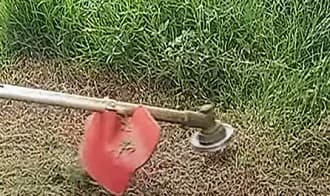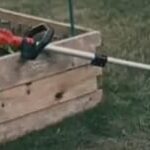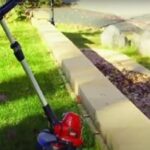As an Amazon Associate, this site earns commissions from qualifying purchases. For more information click here.
Does your weed eater sometimes (or often) stall when you squeeze the trigger? You turn on the engine and it is fine, but then it dies out when you try to use it. As you might have guessed, this is indicative of some kind of engine trouble. In this post we cover the most common causes and detailed fixes.
If a string trimmer dies when you squeeze the trigger, it means there is not fuel getting to the engine. Adjusting the carburetor jets might help. If not, replace the carburetor. A dirty or broken fuel filter is another possible cause.
Check the Fuel Filter
The first place to look is the fuel filter. The filter keeps impurities out so only pure fuel reaches the engine. The filter screens out rust and other debris because these particles will damage engine components.
Because of the way fuel filters work, it accumulates debris and dirt. If the filter is clogged, it can no longer keep debris out. Worse, some of those particles will spread and reach the fuel. If this happens, the engine will have a hard time revving. Even if it starts, the system will eventually shut down.
Solution. The solution is to clean or replace the fuel filter. In most cases it is better to replace it. Cleaning a fuel filter takes time and can be messy. If the filter is old it might even be worn out. So it is more practical to replace it. This will help the performance of a Husqvarna 128CD and other weed eaters for sure.
Whether you decide to clean or replace the fuel filter, the process is the same. Take the spark plug off for precaution. Next, empty the fuel tank.
Look for the fuel line that goes into the tank. Use a pair of pliers to remove it. You will see the fuel filter at the end of the fuel line. Take the filter out. Either clean or replace it. Put everything back together and test the trimmer.
Damaged Fuel Line
The fuel line draws fuel from the tank and sends it to the carburetor. It is a critical engine component and must always be in good working condition.
Just like the fuel filter, the fuel line gets clogged with debris through constant use. These lines are made of rubber which turn brittle with age. If not replaced, the line can break and cause a fuel leak.
Solution. Clean or replace the fuel line. If the fuel line is old, replace it.
Turn the weed eater off and remove the spark plug. Empty the fuel tank. You need to use pliers or a similar tool to take the fuel line off. You might have to take the fuel filter out too. Clean or replace the filter if necessary. Install the new fuel line and the filter.
Other Fuel Issues
There are two more possible fuel issues: not enough gas or the wrong mix ratio for the fuel.
Lack of fuel. If you used the weed eater a week before and forgot to add more fuel, it might simply be out of gas. There is not enough left in the tank so the engine shuts down when the trigger is pulled.
Open the fuel tank and check if there is enough left. Add as much fuel as necessary. Do not let it overfill because that will cause problems too.
Wrong fuel mixture. A 2-stroke weed eater needs a 40:1 or 50:1 mix of fuel and oil. Too much fuel and the mixture is too rich, too little fuel and it becomes lean. So you have to be certain that it is correct.

Air Filter Issues
The air filter screens weeds, grass, rocks and other debris that scatter when you run a weed eater. It is like the fuel filter but the air filter keeps all kinds of debris off the machine.
A fully functional air filter is essential for all weed eaters. If it is clogged, that will affect performance especially if the trimmer line is old.
Weed eater filters can take a good amount of dirt, but eventually it is going to get clogged. You can either clean the filter or replace it.
Solution. Clean weed eater air filters after every 5 hours of use. Replace it every 12 months. This is a general guideline only. The filter might need to be replaced sooner depending on how it is used.
To clean or replace the air filter, remove the cover. It might have screws, bolts or tabs depending on the design. Set the cover aside for now.
Remove the filter. Dust off the dirt and look for indications of tear or cracks. If there are, replace the filter. If there is not, clean it.
For light dirt, a brush will suffice. You can also use a piece of cloth. For more stubborn dirt, use running water or immerse the filter in soapy water. Rinse it afterwards and let it dry. You can squeeze the filter to dry, but be careful. Put the filter back on the trimmer. Screw the cover back on.
Clogged Exhaust
The muffler is part of the exhaust system. The exhaust is responsible for the fuel output and the muffler reduces the noise the process makes.
If you have ever seen a car exhaust, you know these components can accumulate dirt. While string trimmer exhausts and mufflers do not get anywhere as dirty as a car, it still needs maintenance.
Solution. If the engine stops when you press the trigger, the exhaust might be clogged. Weed eaters can get littered with weeds, sticks, grass and other debris. Check the exhaust and the rest of the machine as well.
Use a brush to remove exhaust clog. If the dirt is stuck, a degreaser like the 3D Grand Blast or soapy water should work. A hard brush should be enough to remove the dirt.
Adjust the Carburetor
Many weed eater problems can be resolved by adjusting the carburetor. If you replaced the filters and that did not work, you should look here next.
Solution. The carburetor’s location differs depending on the manufacturer. Usually it is under the air filter and filter cover, so you have to remove those first. Consult your owner’s manual if you are not sure.
Before you make any adjustments, clean the carburetor first. In many cases that is all that’s needed. There are many carburetor cleaning solutions that can get the job done.
Once cleaned, try the trimmer again. If the engine refuses to run, make the following adjustments.
Weed eater carburetors have a high and low jet, marked H and L respectively. Use a screwdriver or a carburetor adjustment tool.
To adjust, shut off the engine. Set the tool over the jet and close the jet. Do this for both high and low.
Turn the jets two times and activate the engine. Let it idle then pull the trigger. If it works, turn the engine off and turn the jets back about 1/8. Turn the engine on again.
If that does not resolve the issue, you may keep adjusting the jets until the engine no longer dies out. If nothing works, you may have to replace the carburetor.
Rebuild or Replace the Carburetor
If cleaning and adjusting the carburetor does not work, you have to either rebuild or replace it. Which one to choose depends on you.
If you want a quick solution, just replace the carburetor. Go to the manufacturer website and enter the weed eater make and model. Look for a carburetor just like yours. The new one includes instructions for removing the old one and installing the new one.
If you are handy with string trimmers, rebuilding is an option. This takes more time but if you have the skills, will cost less.
First you need a carburetor rebuilding kit. You have to remove the carburetor from the trimmer and rebuild it. The kit includes replacement parts so you can put the whole unit back together. Make sure the kit is compatible with your trimmer make and model.

I love the outdoors and all the tools for maintaining gardens, yards and lawns. The only thing I am more passionate about is sharing what I know about garden and outdoor equipment.


